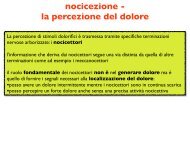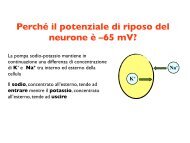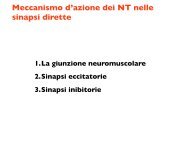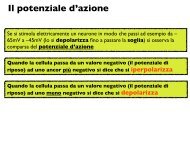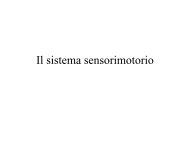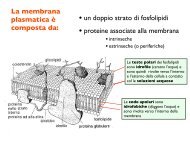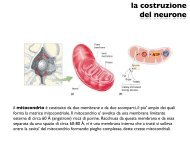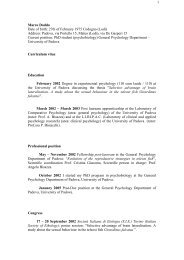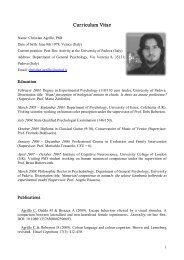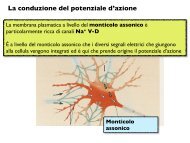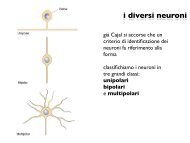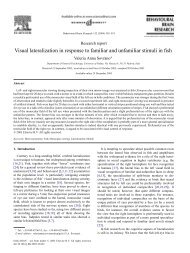Sexual behaviour of immature male eastern mosquitofish: a ... - CPRG
Sexual behaviour of immature male eastern mosquitofish: a ... - CPRG
Sexual behaviour of immature male eastern mosquitofish: a ... - CPRG
Create successful ePaper yourself
Turn your PDF publications into a flip-book with our unique Google optimized e-Paper software.
sexual <strong>behaviour</strong> <strong>of</strong> <strong>immature</strong> <strong>male</strong> mosquit<strong>of</strong>ish 729<br />
constant as possible. Copulatory attempts and successful gonopodial thrusts (observed<br />
contact between gonopodium and fe<strong>male</strong> genital pore) were recorded for each <strong>male</strong> <strong>of</strong> the<br />
two groups. As a measure <strong>of</strong> the efficiency <strong>of</strong> the copulation <strong>behaviour</strong> <strong>of</strong> a <strong>male</strong>, the<br />
ratio between successful gonopodial thrusts and total number <strong>of</strong> copulatory attempts was<br />
calculated.<br />
EFFECT OF THE SEX-RATIO EXPERIENCED BY IMMATURE MALES ON<br />
THEIR SIZE AT MATURITY<br />
The effect <strong>of</strong> the sex ratio on <strong>male</strong> size at maturation was tested using 36 <strong>immature</strong><br />
<strong>male</strong>s (stage 1–2), 72 adult <strong>male</strong>s and 90 adult fe<strong>male</strong>s. The experimental aquaria were<br />
707036 cm in dimension. The natural habitat <strong>of</strong> G. holbrooki is characterized by the<br />
presence <strong>of</strong> dense vegetation. Aquaria were therefore subdivided into six sections, using<br />
vertical partitions, in order to simulate the complexity <strong>of</strong> a natural situation. Partitions<br />
allowed fish to move freely from one compartment to any other. Food was provided<br />
twice a day ad libitum. One <strong>immature</strong> <strong>male</strong> (stage 1 or 2) and two adult <strong>male</strong>s, whose size<br />
exceeded by 40·5 and 70·5 mm that <strong>of</strong> the <strong>immature</strong> <strong>male</strong>, were introduced to each<br />
aquarium. To simulate two situations with different sex ratios, one adult fe<strong>male</strong> was<br />
introduced in some <strong>of</strong> the aquaria (adult <strong>male</strong> : fe<strong>male</strong> ratio=2 : 1, 19 replicates), and<br />
four adult fe<strong>male</strong>s in the rest <strong>of</strong> the aquaria (sex ratio 1 : 2, 17 replicates). Total length<br />
<strong>of</strong> <strong>male</strong>s was measured before the beginning <strong>of</strong> the experiment by using a microscope<br />
with a micrometric ocular. Specimens were observed under the microscope in a Petri dish<br />
filled with water, thus avoiding anaesthetizing <strong>male</strong>s before the experiment. 15 days after<br />
the <strong>immature</strong> <strong>male</strong> matured, it was removed from the aquarium, its total length was<br />
measured and its maturation stage assessed as previously described.<br />
The aquaria used for these experiments did not allow the continuous observation <strong>of</strong> the<br />
<strong>male</strong>s’ <strong>behaviour</strong>. To measure the frequency <strong>of</strong> aggressive and sexual interactions<br />
between <strong>immature</strong> <strong>male</strong>s and adult <strong>male</strong>s, and between <strong>immature</strong> <strong>male</strong>s and fe<strong>male</strong>s,<br />
similar aquaria were used in the middle <strong>of</strong> a dimly-lit room. Twenty-eight replicates were<br />
run (14 with one fe<strong>male</strong> and 14 with four fe<strong>male</strong>s), using <strong>immature</strong> <strong>male</strong>s at stages 5 and<br />
6 <strong>of</strong> gonopodium maturation. For each replicate, <strong>immature</strong>s were kept under observation<br />
for 30 min a day (three periods <strong>of</strong> 10 min, 10 to 15 min apart from each other), for<br />
three consecutive days. Attacks by adult <strong>male</strong>s towards <strong>immature</strong>, attacks by the<br />
<strong>immature</strong> towards the adults, and gonopodial thrusts attempted by the <strong>immature</strong> were<br />
scored, and the fraction <strong>of</strong> time that the <strong>immature</strong> spent in sectors <strong>of</strong> the aquarium where<br />
one or two adult <strong>male</strong>s were also present were measured.<br />
STATISTICAL ANALYSIS<br />
All variables were normally distributed and parametric tests were used. When variance<br />
was not homogeneous between groups, data were logarithmically transformed. Proportional<br />
data were arcsin-root transformed. Statistics were computed with the SPSS/PC<br />
statistical package.<br />
RESULTS<br />
FREQUENCY OF COPULATORY ATTEMPTS IN IMMATURE MALES (Table I)<br />
The size <strong>of</strong> <strong>male</strong>s was significantly different between groups (ANOVA,<br />
F=17·7; d.f.=9, 145; P



